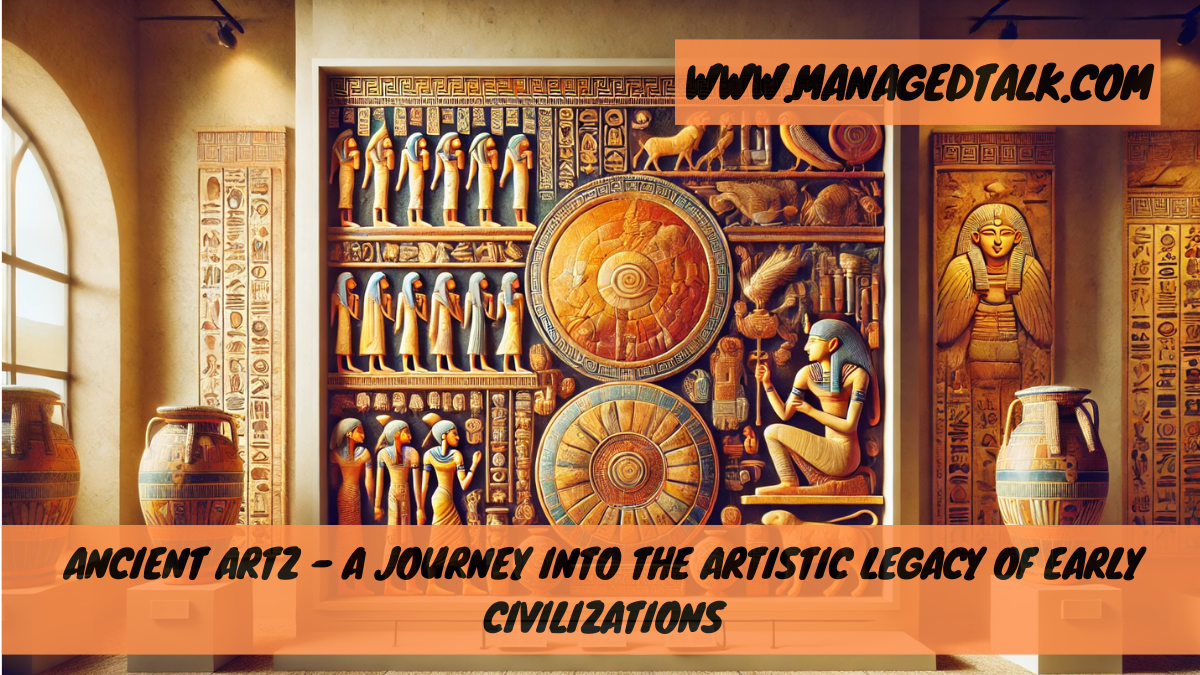Introduction to Ancient Artz
Ancient Artz offers a fascinating glimpse into humanity’s earliest creative expressions. It represents the artistic achievements of ancient civilizations such as the Egyptians, Greeks, Mayans, and others, showcasing their ingenuity and cultural depth. These works go beyond aesthetics—they are a record of societal values, spiritual beliefs, and the technical prowess of early societies.
Ancient Artz showcases the creativity and culture of early civilizations, offering timeless insights into their beliefs, rituals, and lifestyles through artistic expressions like sculptures, paintings, and pottery.
1. What is Ancient Artz?
Ancient Artz refers to the creative works produced by early civilizations that serve as visual narratives of their time. This includes:
- Sculptures: Representations of gods, rulers, or ordinary people.
- Paintings: Found on walls, pottery, and manuscripts.
- Architectural Art: Grand temples and tombs adorned with carvings.
- Decorative Arts: Jewelry and everyday tools turned into objects of beauty.
These art forms were often deeply tied to religious practices, politics, and societal identity, making them crucial to understanding ancient cultures.
2. The Role of Art in Ancient Societies
Art served multiple purposes in ancient civilizations:
- Religious Expression: Depicting gods and rituals.
- Commemoration: Honoring rulers and recording victories.
- Storytelling: Illustrating myths and historical events.
- Utility: Combining functionality with beauty in tools and artifacts.
For example, Egyptian tomb paintings detailed the journey to the afterlife, while Greek pottery illustrated myths and daily life.
3. Key Civilizations and Their Artistic Contributions
Egyptian Art
- Characteristics: Symmetry, symbolism, and monumental scale.
- Famous Examples: The Great Sphinx, intricate wall paintings in pyramids, and Tutankhamun’s golden mask.
- Insights: Egyptian art reveals their strong belief in the afterlife and the divine role of their pharaohs.
Greek and Roman Art
- Greek Contributions: Idealized human forms in sculptures like the Venus de Milo.
- Roman Contributions: Realistic portraits and grand architectural works like the Colosseum.
- Legacy: These works emphasized humanism and innovation in perspective and materials.
Mesopotamian Art
- Notable Works: Ziggurats, detailed reliefs of mythological scenes, and the Ishtar Gate.
- Themes: The relationship between humans and gods, often depicted in a hierarchical scale.
Chinese and Indian Art
- Chinese Art: Intricate jade carvings, terracotta warriors, and landscape paintings.
- Indian Art: The Buddhist sculptures of Ajanta caves and the richly adorned Hindu temples.
Mayan and Aztec Art
- Mayan Contributions: Complex murals and stelae recounting their cosmology.
- Aztec Art: Bold depictions of gods and intricate featherwork.
4. Themes and Symbolism in Ancient Artz
Recurring themes include:
- Spiritual Beliefs: Depictions of gods, afterlife, and creation myths.
- Power and Authority: Kings portrayed as divine or heroic figures.
- Nature and the Cosmos: Use of celestial symbols and animal motifs.
- Human Emotions: Expressions of love, grief, and celebration.
For instance, Mayan art often depicted the cycle of life, while Greek art celebrated human achievements and beauty.
5. Techniques and Materials of Ancient Artists
Ancient artists displayed remarkable resourcefulness in their choice of materials and methods:
- Materials Used: Stone, clay, metals, papyrus, and natural pigments.
- Techniques:
- Sculpting: Mastery in chiseling marble and casting bronze.
- Painting: Use of frescoes and encaustic methods.
- Pottery: Delicate designs and functionality.
Their innovative use of these resources has left us with art that has endured millennia.
6. Preservation and Study of Ancient Artz
Preserving ancient artz is critical to maintaining a connection with the past. This involves:
- Restoration Techniques: Repairing sculptures and retouching faded murals.
- Scientific Analysis: Understanding pigments and materials used.
- Museum Conservation: Storing art in climate-controlled environments.
Excavations and advancements in technology, such as 3D scanning, have also enhanced the study of these works.
7. Modern Relevance of Ancient Artz
Ancient Artz continues to inspire:
- Artistic Movements: Renaissance art drew heavily from Greek and Roman techniques.
- Cultural Identity: Celebrating heritage through traditional motifs.
- Education: Teaching values and historical insights.
It reminds us of humanity’s shared creativity and innovation across ages.
8. FAQs on Ancient Artz
What makes ancient artz unique?
Ancient artz captures the cultural essence of early societies, using symbolic and durable forms of expression to tell their stories.
Why is ancient artz important today?
It offers insights into historical civilizations and inspires modern art, architecture, and cultural preservation.
How can we learn more about ancient artz?
Visiting museums, reading historical accounts, and engaging in educational programs about archaeology and art history.
Conclusion
Ancient Artz bridges the gap between past and present, illuminating the ingenuity and spirit of ancient civilizations. By studying and preserving these works, we honor the legacy of our ancestors while drawing inspiration for the future.
